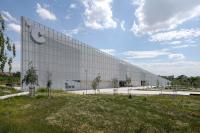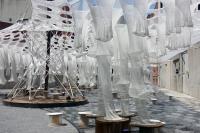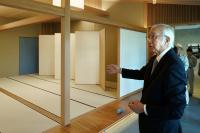Qinmo Primary School
Qinmo Village, China
DESIGNER:
John Lin / The University of Hong Kong
Joshua Bolchover/ The University of Hong Kong
CONTACT:
johnlin@arch.hku.hk
jpbarch@hku.hk
COMMISIONING DONOR:
Matthew Cheng and Peggy Young / Green Hope Foundation, Lucy Tsai / Chinese Culture Promotion Society
ADDITIONAL DONORS:
Luke Him Sau Charitable Trust, Hope Education Foundation, Kadoorie Farm and Garden Corporation
PROJECT COLLABORATORS:
The University of Hong Kong
Sacred Heart Canossian College
CREDITS:
Project Team: Abdul Yeung
Gary Chan, Tammy Chow, Kenneth Lau, Hugo Ma, Tim Mao, Danny Tang and students from Sacred Heart Canossian College
PROJECT DETAILS:
Date: 2006-2008
Size: 1200 sqm
Total Cost: 150,000 usd
Unit Cost: 125 usd/sqm
DESCRIPTION:
Qinmo Village Project is aimed at the long-term sustainable development of a rural Chinese village. The village itself traces its history back 300 years. However as a typical village in China, it is facing massive development and new 3-4 story concrete and tile buildings. Located in Huaji County at the western border of Guangdong Province, the area is one of the poorest in China, with yearly earnings as low as 200 USD yet only 6 hours drive from Hong Kong. The project goes beyond mere building construction by integrating educational programs and sustainable concepts. The construction project involves two buildings, the Qinmo Primary School and the Qinmo Community Center. The first is a new school designed to blend into the village landscape. The second is a project to renovate the old courtyard school building into a community center and demonstration eco household farm.
Initiated in 2006 as part of a design workshop to re-think the standard 3 story concrete buildings which are typically donated as schools in rural areas, the proposed design stressed sustainability and ecological responsibility. Designed to blend into the environment of farming terraces, the roof is also used as a community garden related to the classrooms below. The school itself takes shape through a process of cut and filled earth along an existing rice terrace. A continuous series of steps extends from the basketball court onto the roof creating a new public space in the village. The villagers participated by painting the individual bricks for the facade.
Today the full scope of the work involves 7 different projects which are funded individually by charitable organizations from Hong Kong. Every building project is coupled with a program initiative that emphasizes the education of villagers, whether it is through a school roof garden as an alternative teaching facility or the demonstration eco-household farm. Most importantly by improving on what and how to farm, the economic viability of the villagers can be strengthened. The failure of the farm system forces the young and able-bodied to migrate to cities, finding alternative ways to make a living as migrant laborers. Only the elderly and children remain in most villages. Not only has the concept of a rural livelihood been eroded, the entire social structure is at risk. The project seeks to re-build the notion of the village as a community and to reinforce the idea that education is the primary tool for sustainable development. The designs of the various projects are themselves adapted from and ‘learn’ from the existing typologies and construction methods of rural China. Simple variations in the use of concrete screen or brick work, the adaptation to existing landscape conditions and the re-programming of outdated buildings all inform on the generic conditions of design in rural China. To this day the project continues to involve students, professionals and organizations from China and Hong Kong together in a coordinated effort to explore and find new solutions to the way in which rural transformation can happen.
In 2009, the Qinmo Primary School received an award in the Architecture Review Emerging Architecture Award. In 2010, the Qinmo Village Project received an Honorable Mention in the Urbaninform Competition: Architecture of Social investment. Since the efforts began in 2006, the Qinmo Village has been appointed a key development project by the local government and has been receiving additional assistance to develop its infrastructure.













